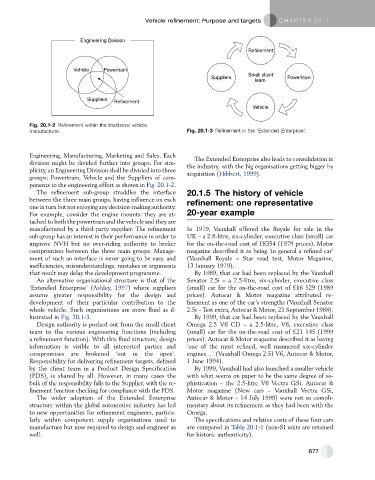Page 666 - Automotive Engineering Powertrain Chassis System and Vehicle Body
P. 666
Vehicle refinement: Purpose and targets C HAPTER 20.1
Engineering Division
Refinement
Vehicle Powertrain
Small client
Suppliers Powertrain
team
Suppliers Refinement
Vehicle
Fig. 20.1-2 Refinement within the traditional vehicle
manufacturer. Fig. 20.1-3 Refinement in the ‘Extended Enterprise’.
Engineering, Manufacturing, Marketing and Sales. Each The Extended Enterprise also leads to consolidation in
division might be divided further into groups. For sim- the industry, with the big organisations getting bigger by
plicity, an Engineering Division shall be divided into three acquisition (Hibbert, 1999).
groups: Powertrain, Vehicle and the Suppliers of com-
ponents to the engineering effort as shown in Fig. 20.1-2.
The refinement sub-group straddles the interface 20.1.5 The history of vehicle
between the three main groups, having influence on each refinement: one representative
one in turn but not enjoying any decision-making authority.
For example, consider the engine mounts: they are at- 20-year example
tached to both the powertrain and the vehicle and they are
manufactured by a third-party supplier. The refinement In 1979, Vauxhall offered the Royale for sale in the
sub-group has an interest in their performance in order to UK – a 2.8-litre, six-cylinder, executive class (small) car
improve NVH but no over-riding authority to broker for the on-the-road cost of £8354 (1979 prices). Motor
compromises between the three main groups. Manage- magazine described it as being ‘in general a refined car’
ment of such an interface is never going to be easy, and (Vauxhall Royale – Star road test, Motor Magazine,
inefficiencies, misunderstandings, mistakes or arguments 13 January 1979).
that result may delay the development programme. By 1989, that car had been replaced by the Vauxhall
An alternative organisational structure is that of the Senator 2.5i – a 2.5-litre, six-cylinder, executive class
‘Extended Enterprise’ (Ashley, 1997) where suppliers (small) car for the on-the-road cost of £16 529 (1989
assume greater responsibility for the design and prices). Autocar & Motor magazine attributed re-
development of their particular contribution to the finement as one of the car’s strengths (Vauxhall Senator
whole vehicle. Such organisations are more fluid as il- 2.5i – Test extra, Autocar & Motor, 21 September 1988).
lustrated in Fig. 20.1-3. By 1999, that car had been replaced by the Vauxhall
Design authority is pushed out from the small client Omega 2.5 V6 CD – a 2.5-litre, V6, executive class
team to the various engineering functions (including (small) car for the on-the-road cost of £21 145 (1999
a refinement function). With this fluid structure, design prices). Autocar & Motor magazine described it as having
information is visible to all interested parties and ‘one of the most refined, well mannered six-cylinder
compromises are brokered ‘out in the open’. engines.’ (Vauxhall Omega 2.5I V6, Autocar & Motor,
Responsibility for delivering refinement targets, defined 1 June 1994).
by the client team in a Product Design Specification By 1999, Vauxhall had also launched a smaller vehicle
(PDS), is shared by all. However, in many cases the with what seems on paper to be the same degree of so-
bulk of the responsibility falls to the Supplier, with the re- phistication – the 2.5-litre V6 Vectra GSi. Autocar &
finement function checking for compliance with the PDS. Motor magazine (New cars – Vauxhall Vectra GSi,
The wider adoption of the Extended Enterprise Autocar & Motor – 14 July 1999) were not so compli-
structure within the global automotive industry has led mentary about its refinement as they had been with the
to new opportunities for refinement engineers, particu- Omega.
larly within component supply organisations used to The specifications and relative costs of these four cars
manufacture but now required to design and engineer as are compared in Table 20.1-1 (non-SI units are retained
well. for historic authenticity).
677

